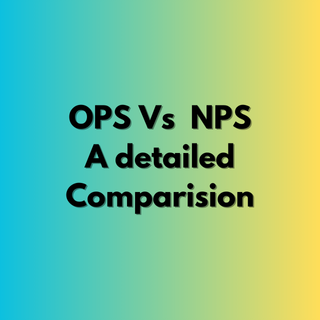
Pension schemes are integral to the financial security of central government employees after retirement. Over the years, there has been a significant shift in the pension system, transitioning from the Old Pension Scheme (OPS) to the New Pension Scheme (NPS). This article provides an in-depth comparison of OPS and NPS, focusing on their features, benefits, and implications for central government employees.
What is the Old Pension Scheme (OPS)?
The Old Pension Scheme, also known as the Defined Benefit Pension System, was the primary retirement benefit plan for central government employees before 2004. It offered guaranteed lifetime pensions based on the last drawn salary and years of service.
Key Features of OPS:
- Guaranteed Pension: OPS provided a fixed monthly pension calculated as 50% of the last drawn basic salary plus dearness allowance (DA).
- Dearness Relief (DR): Pensioners received periodic increases in their pension amount through Dearness Relief adjustments, mitigating the effects of inflation.
- No Employee Contribution: Employees did not have to contribute towards the pension fund.
- Family Pension: In case of the pensioner’s death, a family member received a pension.
- Gratuity Benefits: Employees under OPS were eligible for gratuity payments as an additional retirement benefit.
Drawbacks of OPS:
- The system posed a significant financial burden on the government.
- Increasing pension liabilities led to unsustainable fiscal pressures.
What is the New Pension Scheme (NPS)?
Introduced in January 2004, the New Pension Scheme is a Defined Contribution Pension System aimed at reducing the financial burden on the government. It is mandatory for central government employees who joined service on or after January 1, 2004.
Key Features of NPS:
- Employee Contribution: Employees contribute 10% of their basic salary and DA, matched by a 14% contribution from the government.
- Market-Linked Returns: Pension funds under NPS are invested in market instruments like equities, government bonds, and corporate debt, leading to variable returns.
- Tiered Structure:
- Tier I Account: Mandatory retirement account with withdrawal restrictions.
- Tier II Account: Voluntary savings account with flexible withdrawals.
- Tax Benefits: Contributions to NPS qualify for tax deductions under Sections 80C and 80CCD(1B) of the Income Tax Act.
- Annuity Purchase: At retirement, 40% of the corpus must be used to purchase an annuity, ensuring a regular pension. The remaining 60% can be withdrawn as a lump sum.
- Portability: NPS accounts are portable across jobs and locations.
Drawbacks of NPS:
- Returns are market-dependent, leading to uncertainty.
- Unlike OPS, NPS does not guarantee a fixed pension amount.
- Pension depends on the performance of fund managers and market conditions.
Comparative Analysis: OPS vs. NPS
1. Pension Amount
- OPS: Offers a fixed pension based on the last drawn salary.
- NPS: Pension depends on the corpus accumulated and annuity purchased.
2. Financial Security
- OPS: Provides greater financial security with inflation-indexed pensions.
- NPS: Financial security varies due to market-linked returns.
3. Employee Contribution
- OPS: No contribution required from employees.
- NPS: Employees must contribute 10% of their basic salary and DA.
4. Flexibility
- OPS: Fixed structure with limited flexibility.
- NPS: Offers flexibility in investment choices and partial withdrawals.
5. Government Liability
- OPS: High financial burden on the government.
- NPS: Reduced fiscal pressure due to shared contributions.
Office Memorandums and Notifications Related to OPS and NPS
- Pension Fund Regulatory and Development Authority (PFRDA):
- The PFRDA oversees the NPS framework. Employees can visit PFRDA’s official website for updates on fund managers, annuity options, and related guidelines.
- Department of Pension and Pensioners’ Welfare (DoPPW):
- Notifications regarding OPS implementation and family pensions are available at DoPPW’s website.
- Clarifications on NPS:
- Circulars like OM No. 57/04/2019-P&PW(B) clarify various aspects of NPS, including tax benefits and withdrawal rules.
Why Are Employees Advocating for OPS?
Despite the government’s intent to reduce fiscal liabilities, many central government employees favor the return of OPS for the following reasons:
- Predictable Income: OPS guarantees a steady income, shielding pensioners from market fluctuations.
- Inflation Adjustment: Dearness Relief ensures that pensions keep pace with rising prices.
- Family Benefits: OPS offers better security to family members in case of the pensioner’s death.
Several states, including Rajasthan, Chhattisgarh, and Himachal Pradesh, have reinstated OPS for state government employees, reigniting debates among central employees.
Key Considerations for Central Government Employees
When comparing OPS and NPS, employees should consider:
- Retirement Goals: Employees prioritizing guaranteed income may prefer OPS, while those seeking higher potential returns might favor NPS.
- Investment Knowledge: NPS requires awareness of market dynamics and fund performance.
- Family Needs: Consider family pension benefits and financial security.
- Long-Term Stability: Evaluate the stability and predictability of each scheme.
Transition from NPS to OPS: Is It Possible?
Central government employees who joined after 2004 are automatically enrolled in NPS. Transitioning back to OPS is currently not allowed for these employees. However, employee unions and associations continue to advocate for policy changes to reinstate OPS.
Employees must stay updated with notifications from the Department of Personnel and Training (DoPT) and the Ministry of Finance.
Conclusion
Both OPS and NPS have distinct advantages and disadvantages. While OPS provides guaranteed financial security, it imposes a heavy fiscal burden on the government. On the other hand, NPS offers flexibility and shared contributions but lacks predictability.
For central government employees, the choice between OPS and NPS depends on individual priorities, risk tolerance, and financial goals. Staying informed about policy updates and engaging with employee associations can help in navigating these schemes effectively.
Leave a Reply